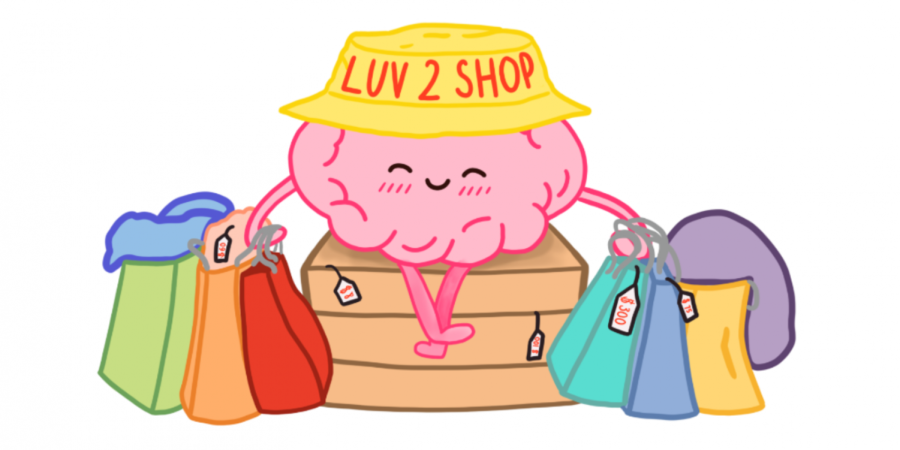Does retail therapy inspire relief or unhealthy reliance?
Graphic illustration by Anwen Huang
When a person shops, the brain releases dopamine as a response to the perception of a reward. The surge of happiness and positive feelings that ensues makes retail therapy an addictive method of stress relief.
November 9, 2021
In-store or online shopping is a common leisure activity, but it is also a method of stress relief that many people engage in, both consciously and unconsciously. Retail therapy, the act of buying something with the intention of lifting one’s mood, provides shoppers with psychological rewards and is a proven outlet for releasing feelings of negativity. However, the behavior can develop into an unhealthy coping mechanism if one’s impulsivity goes unchecked.
The term retail therapy stems from its effectiveness in relieving stress. Similar to how people often crave sweets when stressed, many turn to shopping when under pressure. Shoppers form a psychological connection between spending money and positive emotions because shopping promises a material reward. When someone shops, dopamine, a neurotransmitter that interacts with the pleasure and reward center of the brain, is released along with other chemicals including serotonin, oxytocin and endorphins. Dopamine naturally increases happiness levels and feelings of well-being, while serotonin, oxytocin and endorphins stabilize one’s mood.
“I don’t know if I do it to relieve stress consciously,” sophomore Justin Tseng said. “But I feel like there’s definitely a level where if I’m super stressed, sometimes I’ll just say, ‘Okay, I’m going to go shop for an hour.’”
Even simply filling up an online shopping cart and abandoning it can produce feelings of satisfaction. “Window shopping,” or scrolling through a website or browsing in a store without actually making a purchase, can boost mood due to the anticipation for a reward, and studies have shown that dopamine is released before a purchase is even made. Similarly, eagerly waiting for a package or saving up for a big purchase can be therapeutic because it builds excitement and releases dopamine over time. Since the desire to continue “feel-good” activities is increased by dopamine, shopping, and hence retail therapy, can be extremely addictive.
“If I wanted to take a break from stressful stuff, I could do something like watch a movie,” senior Oviya Seeniraj said. “But for me, retail therapy is the most satisfying because I can get something out of it while also being able to give my brain a break.”
Several other factors also explain retail therapy’s allure. For one, shopping can help restore a sense of control in someone’s life. When people make decisions with money, they feel an augmented sense of responsibility and may experience greater self-esteem after making a purchase. In a 2014 study by the University of Michigan, researchers found that purchasing items one enjoys can be 40 times more effective at establishing a sense of control than not shopping. Simply browsing was also found to ease general feelings of sadness, but subjects who made a purchase were on average three times happier than those who did not buy anything.
“When we feel stressed, we feel out of control, right?” De Anza College Psychology professor Robin Schulte said. “Shopping is one of these things where it makes you feel in control.”
Shopping also keeps feelings of stress at bay by stimulating the senses. Brightly-lit stores and flashy websites encourage visualization, a technique known to fight anxiety by forcing one to focus on a single object or color rather than their entire surroundings, which can be chaotic and overwhelming.
Recently, shopping has become more accessible with the convenience of the internet. The additional outlet of online shopping, in particular, has gained even more popularity since the COVID-19 pandemic. Isolation during the pandemic has also pushed more people to turn to retail therapy as a distraction from their loneliness.
Although retail therapy provides many benefits, too much of it can be harmful. Transactions intended for relief may become a dangerous shopping and stress paradox if they get out of hand. If one’s only avenue to relieve stress is through retail therapy, then they will only receive temporary gratification from materialistic items that fail to address the root of their negative emotions. Compulsive shoppers like this are often labeled as “shopaholics,” and obsessive shopping can escalate into addictions such as oniomania, compulsive buying disorder, buying-shopping disorder and pathological buying. These extreme forms of retail therapy cause shoppers to experience doubt, anxiety, frustration and feelings of loss of control. As with all coping strategies, excessive use of shopping as therapy can reach a point where it is unhealthy and counterproductive to its intended advantages.
“People generally engage in two types of coping: active coping, which is a coping method where people try to actively address the problem at hand, and passive coping, where people engage in activities that help them escape from their problems,” De Anza College Psychology professor Taiki Kondo said. “Generally, it’s fine to do the second one every now and then, but you are eventually going to have to address the problem.”
With both pros and cons, retail therapy can be effective if managed properly. Recognizing what triggers one to shop, making a budget to stick to and postponing purchases to a later time to ensure the items are still wanted are all methods to combat falling down the rabbit hole of retail therapy. Shopping can help decompress, but it has limits and should not be used as a singular stress relief method.




































































